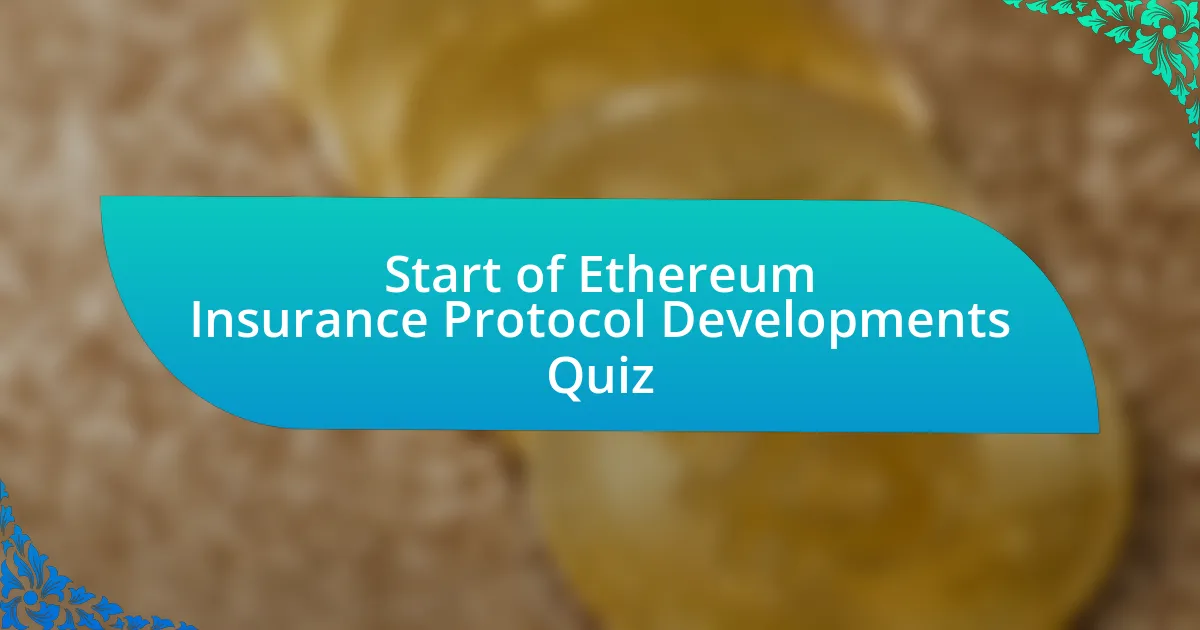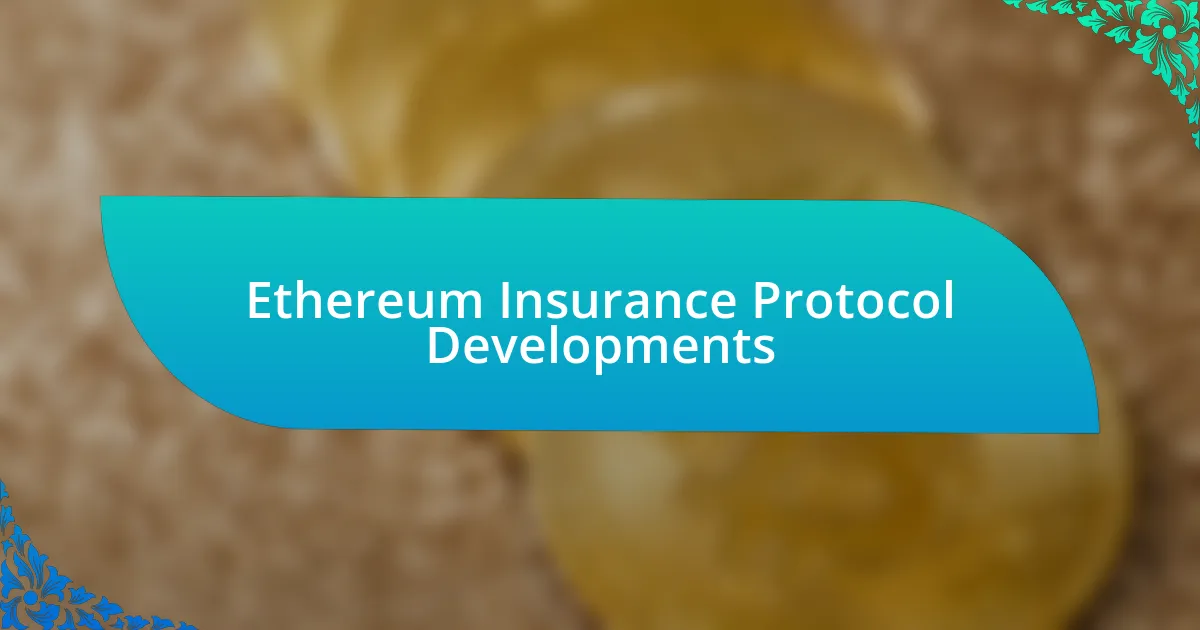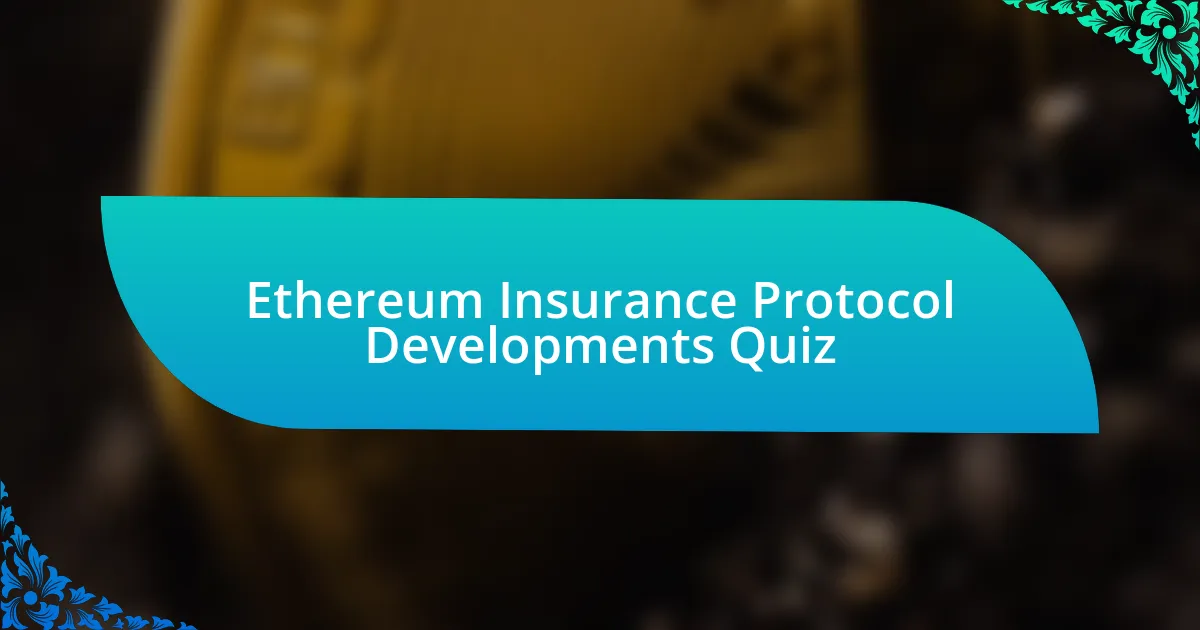
Start of Ethereum Insurance Protocol Developments Quiz
1. What is the main concept introduced in the `Collaborative and parametric insurance on the Ethereum blockchain` paper?
- The paper introduces a blockchain-based insurance scheme that integrates parametric and collaborative elements.
- The paper evaluates the risks of blockchain technology unrelated to insurance.
- The paper focuses solely on traditional insurance methods without blockchain.
- The paper discusses decentralized finance without insurance elements.
2. Who are the surplus providers in the Ethereum insurance scheme?
- Surplus providers lock funds in a smart contract.
- Surplus providers calculate the premiums for policies.
- Surplus providers issue insurance policies directly to users.
- Surplus providers manage the funds for investors.
3. How are participants` token rights structured in the insurance scheme?
- Tokens are distributed to all participants, reflecting their stake in the system.
- Tokens are allocated randomly to participants without criteria.
- Tokens are solely issued to surplus providers based on contributions.
- Tokens are given only to policyholders based on their premiums.
4. Which programming language is utilized for smart contract development on Ethereum?
- Solidity
- Python
- C++
- JavaScript
5. On which network is the insurance smart contract deployed?
- Binance Smart Chain
- Main Ethereum network
- Ropsten network
- Sepolia testnet
6. What is the function of premium loading within this insurance framework?
- The premium loading directly adds to policyholders` coverage amounts.
- The premium loading increases the initial investment requirement for surplus providers.
- The premium loading is solely for funding marketing expenses and promotions.
- The premium loading covers management costs and provides returns for investors, with a portion redistributed to policyholders in the form of protocol tokens.
7. How do policyholders receive compensation for claims under this Ethereum insurance model?
- Policyholders receive gift cards.
- Policyholders receive ETH payments.
- Policyholders receive cash payments.
- Policyholders receive DAI tokens.
8. What does the Solvency Capital Requirement (SCR) represent in insurance terms?
- The minimum capital required to cover the risk.
- The amount of premium paid by policyholders.
- The maximum profit allowed in insurance contracts.
- The total assets owned by an insurance company.
9. What occurs if the smart contract`s funds fall below the predetermined Minimum Capital Requirement (MCR)?
- All contracts become void immediately.
- The funds are automatically returned to surplus providers.
- The system files for bankruptcy and reimburses policyholders.
- A penalty fee is charged to investors.
10. What advantages do investors gain from holding tokens in the insurance model?
- Investors are guaranteed a fixed return regardless of market conditions.
- Investors receive voting rights and share of insurance pool surplus.
- Investors receive exclusive access to all insurance policy details.
- Investors must pay fees to hold their tokens indefinitely.
11. Which consensus algorithm is currently adopted by the Ethereum network?
- Delegated Proof-of-Stake (DPoS)
- Proof-of-Stake (PoS)
- Byzantine Fault Tolerance (BFT)
- Proof-of-Work (PoW)
12. What role do smart contracts play in the Ethereum ecosystem?
- Smart contracts serve as manual transaction processors in Ethereum.
- Smart contracts automate trustless transactions in Ethereum.
- Smart contracts create physical assets in the Ethereum network.
- Smart contracts only store user data in Ethereum.
13. How do Ethereum nodes communicate within the network?
- Ethereum nodes communicate using HTTP requests.
- Ethereum nodes communicate using a peer-to-peer network.
- Ethereum nodes communicate using the Ethereum blockchain protocol.
- Ethereum nodes communicate using email services.
14. What is the significance of private keys in Ethereum transactions?
- Private keys track transaction history.
- Private keys are used to mine new Ether.
- Private keys encrypt user data.
- Private keys are used to sign transactions.
15. What is the purpose of gas fees in executing smart contracts?
- Gas is a flat fee charged by miners for all transactions executed.
- Gas determines the maximum amount of data that can be stored on the blockchain.
- Gas is used to pay for the computational effort required to execute smart contract functions.
- Gas is used as a reward for users providing liquidity to exchanges.
16. What happens to a transaction if gas runs out before completion?
- All state changes are reversed, and the used Ethereum Gas is given to the miner.
- The transaction is automatically approved and executed.
- The funds are refunded to the sender immediately.
- The transaction is saved in the blockchain for future processing.
17. What is the function of Remix regarding smart contracts?
- Remix is a wallet service for storing digital assets securely.
- Remix is an online tool used to deploy, test, and develop smart contracts.
- Remix is a cryptocurrency exchange platform for trading tokens.
- Remix is an auditing service for smart contracts to ensure compliance.
18. How do transactions differ between Bitcoin and Ethereum in checking account states?
- Bitcoin checks unspent transaction outputs (UTXO), while Ethereum checks the latest account balance.
- Bitcoin uses account balances while Ethereum checks the transaction history.
- Bitcoin tracks all transactions and Ethereum uses UTXOs for state checking.
- Bitcoin verifies the latest account state and Ethereum validates UTXOs.
19. What is the primary use case for a Testnet in Ethereum?
- The Testnet is used for creating new Ethereum mainnets.
- The Testnet is used for storing real user data securely.
- The Testnet is used for testing DApps and smart contracts without real Ether.
- The Testnet is used for building physical infrastructure.
20. Is real Ether necessary for testing decentralized applications and smart contracts?
- Yes, real Ether is necessary for all tests.
- No, you can use free Ether in test networks.
- No, only real Ether from the mainnet is sufficient.
- Yes, testing requires acquiring Ether from exchanges.
21. How is spending accounted for in smart contracts with respect to costs?
- Contract operations always incur transaction costs regardless of changes.
- Spending is free as long as the balance is above zero.
- Spending that modifies the contract incurs Gas costs.
- All spending in smart contracts incurs a flat fee.
22. What yield can users achieve through the Insurance Liquidity feature in Bright Union?
- 5-10% APY
- 50-60% APY
- 30-35% APY
- 15-25% APY
23. What variety of insurance products does Bright Union provide?
- Bright Union focuses solely on health insurance plans.
- Bright Union specializes in auto insurance exclusively.
- Bright Union only provides life insurance products.
- Bright Union offers various types of insurance products including protocol risk insurance.
24. How does the Integrator service streamline API development for insurance products?
- The Integrator service automates customer service responses for insurance inquiries.
- The Integrator service generates in-depth insurance policy documentation automatically.
- The Integrator service allows developers to integrate insurance products into any app or wallet with just three lines of code.
- The Integrator service provides analytics tools for assessing insurance risks.
25. What are the two types of coverage offered by Neptune Mutual?
- Flexible and Fixed Covers
- Comprehensive and Limited Covers
- Standard and Extended Covers
- Dedicated Covers and Diversified Covers
26. How does Neptune Mutual facilitate quick payouts to users?
- Users must submit a detailed claim and wait for approval.
- Users can collect stablecoin payouts immediately without providing personally identifiable information or evidence of loss.
- Users receive payouts only after a long review process.
- Users must provide extensive documentation to access payouts.
27. What role does the SDK play in integrating insurance features within DeFi applications?
- The SDK evaluates insurance claims from users automatically.
- The SDK allows DeFi apps to integrate Neptune Mutual`s insurance features directly.
- The SDK prevents unauthorized transactions within DeFi applications.
- The SDK provides investment advice for DeFi projects.
28. What unique token does Nexus Mutual use for its operations?
- BTC
- NXM
- LTC
- ETH
29. How does Nexus Mutual cultivate a self-sustaining insurance ecosystem?
- Members can stake NXM tokens to provide underwriting liquidity, creating a self-sustaining ecosystem.
- Members trade NXM tokens to invest in external projects without any returns.
- Members participate in games to earn NXM tokens and build social connections.
- Members donate NXM tokens to charity organizations as part of a community initiative.
30. What are the functions of the payment and underwriting pools in InsurAce?
- These pools are solely for investment returns and do not involve insurance.
- These pools focus on marketing strategies for attracting new users.
- These pools exclusively handle customer complaints and support issues.
- These pools manage the community funds and facilitate risk management.

Congratulations! You’ve Completed the Quiz
Thank you for participating in our quiz on Ethereum Insurance Protocol Developments. We hope you found the questions engaging and informative. Quizzing yourself is a fantastic way to reinforce knowledge, and we’ve aimed to provide insights that deepen your understanding of this crucial topic.
Throughout this quiz, you may have learned about the innovative solutions Ethereum offers for insurance. Concepts like smart contracts and decentralized finance can seem complex at first. However, this quiz has shed light on how these elements interact to provide better risk management and trust in insurance. Understanding these developments is essential as the industry continues to evolve.
If you want to dive deeper, we invite you to explore the next section on this page. It is packed with valuable information about Ethereum Insurance Protocol Developments. Expanding your knowledge in this area can inspire you and equip you with the tools needed to navigate the changing landscape of insurance using blockchain technology. Happy learning!

Ethereum Insurance Protocol Developments
Overview of Ethereum and its Role in Decentralized Insurance
Ethereum is a decentralized blockchain platform that enables smart contracts and decentralized applications (dApps). One of its significant applications is in the insurance industry, which benefits from Ethereum’s transparency and security features. Decentralized insurance protocols built on Ethereum facilitate peer-to-peer insurance, eliminating the need for traditional intermediaries. This model enhances trust and reduces costs, providing users with seamless insurance policy management.
Key Developments in Ethereum-Based Insurance Protocols
Recent developments include the emergence of innovative protocols like Nexus Mutual and Etherisc. These platforms use Ethereum to offer decentralized insurance solutions. They allow users to pool funds and share risk among members. Enhanced security measures, claims processing automation, and user governance structures are critical advancements. These features improve reliability and user experience, essential for adopting decentralized insurance.
Technological Innovations Enhancing Smart Contracts in Insurance
Smart contracts are pivotal in Ethereum insurance protocols, automating terms and claims processing. Recent innovations have focused on making these contracts more robust and secure. Improved programming languages and audit tools ensure that contracts execute as intended without risks of exploits. Furthermore, integrations with oracles allow real-world data to influence contract outcomes, enhancing transparency and trust in the insurance processes.
Challenges Faced by Ethereum Insurance Protocols
Ethereum-based insurance protocols face several challenges, including regulatory compliance and scalability issues. Regulatory uncertainty can hinder the adoption of decentralized insurance solutions. Additionally, Ethereum’s scalability problems affect transaction speeds and costs during high demand periods. These challenges must be addressed to ensure the sustainable growth of Ethereum insurance applications and consumer trust.
Future Trends in Ethereum Insurance Development
The future of Ethereum insurance protocols may involve enhanced interoperability between different blockchains. This change could allow for seamless integration of insurance services across various platforms. Moreover, the rise of decentralized finance (DeFi) is likely to influence insurance models, creating more innovative risk-sharing mechanisms. The ongoing development of layer 2 solutions will also enhance transaction efficiency, fostering broader adoption of Ethereum-based insurance.
What is the Ethereum Insurance Protocol?
The Ethereum Insurance Protocol is a decentralized system built on the Ethereum blockchain, designed to provide insurance solutions through smart contracts. It allows users to create and manage insurance policies without intermediaries. The protocol leverages blockchain technology to ensure transparency, security, and trust in transactions. Various projects like Etherisc and InsurAce exemplify the application of this protocol, providing coverage for different risks such as flight delays and cryptocurrency hacks.
How does the Ethereum Insurance Protocol work?
The Ethereum Insurance Protocol operates by utilizing smart contracts that automate the insurance process. Users can purchase policies directly through the platform. When a claim is made, the smart contract checks predefined conditions and automatically approves or denies the claim based on the input data. This automation minimizes the need for manual intervention and reduces processing time, leading to faster payouts. It also enhances the accuracy of claims assessment, as it relies on objective data.
Where can developers find resources for Ethereum Insurance Protocol projects?
Developers can find resources for Ethereum Insurance Protocol projects on various platforms, including GitHub, where many open-source projects are hosted. Additionally, official documentation from insurance-related blockchain projects like Etherisc provides guides and tutorials. Developer communities on forums like Reddit and Stack Exchange also serve as valuable resources, sharing knowledge and expertise about building on the Ethereum network.
When did Ethereum-based insurance protocols start gaining traction?
Ethereum-based insurance protocols began gaining traction around 2017 during the initial coin offering (ICO) boom. Projects like Etherisc launched to address gaps in traditional insurance by offering decentralized solutions. The growing interest in decentralized finance (DeFi) and blockchain technology has further propelled the development of these protocols, especially after significant market events that highlighted the need for alternative insurance models.
Who are the key players in the Ethereum Insurance Protocol space?
Key players in the Ethereum Insurance Protocol space include projects like Etherisc, InsurAce, and Nexus Mutual. Etherisc focuses on creating decentralized insurance applications for various use cases, such as flight delay insurance. InsurAce offers coverage for DeFi protocols and yield farming risks. Nexus Mutual operates as a decentralized insurance platform allowing users to pool resources for coverage, emphasizing community governance and mutual benefits.

